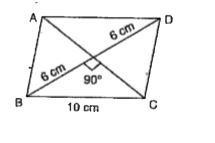What will be the perimeter of square. If the sum of lengths of diagonal is 144 cm.
144 cm
144V2cm
288 cm
228^" cm
The correct Answer is:B
To find the perimeter of a square when the sum of the lengths of its diagonals is given, we can follow these steps:
Step 1: Understand the properties of the square
A square has four equal sides and two equal diagonals. The length of each diagonal can be calculated using the formula:
D=a√2
where D is the length of the diagonal and a is the length of one side of the square.
Step 2: Set up the equation for the diagonals
According to the problem, the sum of the lengths of the diagonals is 144 cm. Since both diagonals are equal, we can express this as:
D+D=144
This simplifies to:
2D=144
Step 3: Solve for the length of one diagonal
To find the length of one diagonal D, we divide both sides of the equation by 2:
D=1442=72 cm
Step 4: Relate the diagonal to the side of the square
Using the relationship between the diagonal and the side of the square, we can substitute D into the formula:
D=a√2
Thus:
72=a√2
Step 5: Solve for the side length a
To find the side length a, we rearrange the equation:
a=72√2
Step 6: Rationalize the denominator
To simplify a, we multiply the numerator and denominator by √2:
a=72√22=36√2 cm
Step 7: Calculate the perimeter of the square
The perimeter P of a square is given by:
P=4a
Substituting the value of a:
P=4×36√2=144√2 cm
Final Answer
The perimeter of the square is:
144√2 cm
A square has four equal sides and two equal diagonals. The length of each diagonal can be calculated using the formula:
D=a√2
where D is the length of the diagonal and a is the length of one side of the square.
According to the problem, the sum of the lengths of the diagonals is 144 cm. Since both diagonals are equal, we can express this as:
D+D=144
This simplifies to:
2D=144
To find the length of one diagonal D, we divide both sides of the equation by 2:
D=1442=72 cm
Using the relationship between the diagonal and the side of the square, we can substitute D into the formula:
D=a√2
Thus:
72=a√2
To find the side length a, we rearrange the equation:
a=72√2
To simplify a, we multiply the numerator and denominator by √2:
a=72√22=36√2 cm
The perimeter P of a square is given by:
P=4a
Substituting the value of a:
P=4×36√2=144√2 cm
The perimeter of the square is:
144√2 cm
Topper's Solved these Questions
Similar Questions
Knowledge Check
- Question 1 - Select One
Find the area of a square if the sum of the diagonals is 100 cm .
A100√2cm2B1250cm2C125cm2D5000cm2 - Question 2 - Select One
The circumference of a circle is equal to the perimeter of a square. If the length of the diagonal of the square is 11√2cm, then what is the area of the circle ?
A77 sq. cmB154 sq. cmC121 sq. cmD49 sq. cm - Question 3 - Select One
Find the perimeter of the rectangle whose length is 40cm and a diagonal is 41cm.
A97cmB89cmC98cmD88cm
Find the perimeter of a rhombus ,the lengths of whose diagonal are 16cm and 30 cm.
View SolutionThe area of a square is 144cm2. What is the perimeter of the square formed by the diagonal of the original square as its side?
एक वर्ग का क्षेत्रफल 144 वर्ग सेमी है| आरंभिक वर्ग के विकर्ण को भुजा मानकर बनाए गए वर्ग का परिमाप क्या होगा ?View SolutionWhat will be the perimeter of a rectangle if its length is 3 times its width and the length of the diagonal is 8√10 cm?
View SolutionThe perimeter of a square is 120 cm and the perimeter of a rectangle is equal to the perimeter of the square. The length of the rectangle is 6 cm more than the side of the square. The sum of the areas (in cm2 ) of the square and the rectangle is
View SolutionPerimeter of a square is 44 cm. The perimeter of a rectangle is equal to the perimeter of this square. The length of the rectangle is 5 cm more than the side of the square. The sum of areas (in cm2) of the square and the rectangle is
View Solution


